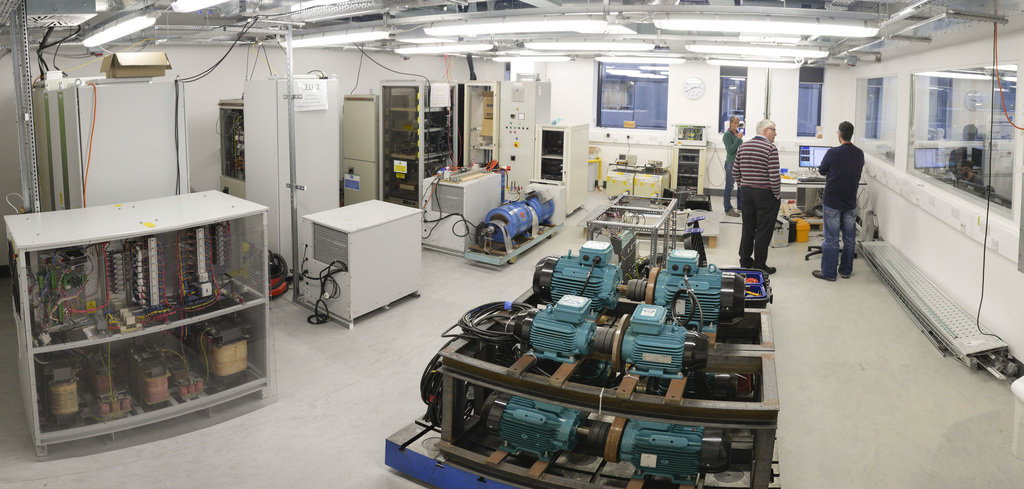 |
Country: United Kingdom |  |
||
| Get free physical and remote access to this facility its virtual services via the ERIGrid 2.0 Lab Access Programme. |
||||
| Submit Testing/Consulting Request | ||||
Description: The Institute for Energy and Environment (InstEE) represents one of Europe’s largest power systems and energy technology university research groups. Comprising 32 members of academic staff, over 200 research staff and students, and 18 technical and administrative colleagues, the Institute has four main research groups:
- Advanced Electrical Systems
- High Voltage Technology
- Power Electronics Drives and Energy Conversion
- Wind Energy and Control
There are 45 bespoke, state of the art laboratories across key research themes of energy, health, manufacturing, and future cities – which support innovation and research demonstration. This is complemented by the Power Networks Demonstration Centre (PNDC) which hosts a fully operational HV and LV demonstration network and dedicated team of research, technical and support staff.
The laboratory has a real-time link to several research infrastructures across the world including Nokia Laboratory in USA and Rolls-Royce Corporate lab in Singapore.
Description: The Institute for Energy and Environment at the University of Strathclyde offers the experimental facility “Distribution Network and Protection Laboratory”, D-NAP. This comprises a 100kVA microgrid that can operate grid connected or variously islanded, integrated with a real-time digital network simulator and protection injection laboratory. The facility offers hardware-in-the-loop capability, and incorporates induction machines, programmable load banks and various 1/3 - phase inverters.
Significant hardware has been added to the microgrid infrastructure, including: lithium-ion battery storage (10 kVA), supercapacitor energy storage (192 kW peak power), and their corresponding interfacing converters.
A new RTDS NovaCor and Aurora link enable larger-scale simulations and high fidelity PHIL demonstrations. A unique platform for wide-area monitoring, protection, and control with 64 PMUs has been developed, where PMU algorithms execute on a cluster of Raspberry Pis with waveform data from real-time simulations using GTFPGA unit
Technical specifications (PDF)
more information
Tri-phase unit
Description: 90kVA
Hardware-in-the-Loop system
Description: Real-time PHIL co-simulation platform
1/3 – phase inverters
100kVA microgrid
Real-time Digital Network Simulator
PMU devices
Description: Distributed measurement architecture
IEC 61850 GOOSE
Description: Messaging for laboratory control funtionality
Real-time communications emulation
Description: Enabling arbitrary manipulation of Ethernet traffic
Programmable load banks
Description: The High Voltage Technologies (HVT) and Electrical Plant Diagnostics Group is engaged in fundamental and applied research covering electrical plant, pulsed power technologies and high voltage (HV) materials and components. HVT has a strong track record of pioneering research into many practical applications of HV technology and has spun out four successful companies in recent years. HVT research covers a range of challenging topics, including ultra-fast high energy switches for particle beam fusion experiments; measurement and location of partial discharges in electrical insulation; inactivation of bacteria using electrical impulses, and diagnosis of defects in HV equipment such as GIS, transformers and cables.
Power Networks Demonstration Centre (PNDC)
Description: The Power Networks Demonstration Centre (PNDC) offers an ideal platform to accelerate the development of these technologies through its staff and facilities, and to reduce delivery risk.
Through the use of a fully operational HV and LV demonstration network (operated either as a grid connected or as an islanded system), integrated with state-of-the-art communications and monitoring equipment, as well as other bespoke integrated functionality, i.e. dedicated fault throwing capability. PNDC is playing a key role in accelerating emerging technologies towards commercial deployment in a realistic, controllable environment.
For an enhanced RTDS capability of the laboratory, two new RTDS cubicles are available, integrated with a 1MW motor-generator set to enable PHIL testing. Among other scopes, the PHIL setup is used for testing wide area control systems which are utilised to provide fast frequency control in situations of grid disturbances/faults.
Over the last 12 months the PNDC has enhanced its 11kV distribution network test environment. This includes increasing the scope of our fault throwing capability, to now include the introduction of intermittent (‘pecking’) faults on our low-voltage (LV) network. Our communications test-bed now includes the latest in secure networking, including industrial firewalls and intrusion detection software. This has allowed us to deliver projects such as penetration testing of specific network assets, utilizing both physical and virtual networks. Additionally, we have supported the testing of asset discovery tools for use in distribution network environment.
Technical specifications (PDF)
Power Networks Demonstration Centre (PNDC) - Electric Vehicles Research
Description: PNDC has capabilities for researching and demonstrating the interaction between the grid and electric vehicles. The facilities include plugin AC and DC charging stations connected to the 400 V network and a wireless 60 kW inductive charging station for heavy-duty vehicles. The network is controlled using an RTDS or SCADA and can run between 49.6 – 61 Hz. This allows investigations into network effects on vehicle charging processes and battery life and the use of smart grid components such as distributed storage and generation. There is also a unique tool to investigate and model vehicle state of charge to support control and forecasting as well as passenger comfort.
Smartgrid MVP
Smartgrid MVP [formerly RT-Stream] of the Dynamic Power Systems Laboratory (DPSL) collects power systems measurement data form multiple data sources, including from Phasor Measurement Units (PMUs), within a single platform. This enables the data to be shared with other interested parties, in real-time (or near-real-time). Furthermore, historical recorded data (e.g., within a certain time range) will be available to access and download. Optionally, analysis can be performed locally on the data, such as correlation with other power system events and data sources.
- Technology validation of novel communications networks
- Comprehensive testing of power system protection relay settings
- Testing of small DER interfaces and components with PHIL experiments
- Scaled testing of power system controls
PNDC Publications:
- J. Melone, J. Zafar, F. Coffele, A. Dyko:
A Model-Based Analysis Method for Evaluating the Grid Impact of EV and High Harmonic Content Sources
International Journal of Distributed Energy Resources and Smart Grids: Special Issue on Grid Integration and Interoperability Assessment of Electric Vehicles, DERlab, 2015. - B. Stephen, X. Tang, P. Harvey, S. Galloway, K. Jennett:
Incorporating practice theory in sub-profile models for short term aggregated residential load forecasting
IEEE Transactions on Smart Grid, IEEE, 2015. - M. Segovia, V. Catterson, A. Stuart, L. Johnston, H. Bain, R. McPhaded, R. Wylie, A. Hernandez:
Predicting remaining life of tower steelwork components
European Safety and Reliability, 2016. - I. Abdulhadi, A. Dyśko:
Hardware Testing of Photovoltaic Inverter Loss of Mains Protection Performance
Developments in Power System Protection, IET, 2016. - V. Catterson, J. Melone, M. Segovia:
Prognostics of transformer paper insulation using statistical particle filtering of on-line data
IEEE Electrical Insulation Magazine, IEEE, 2016.
D-NAP Publications:
- S. M. Blair, C. D. Booth, G. Williamson, A. Poralis, and V. Turnham:
Automatically Detecting and Correcting Errors in Power Quality Monitoring Data
IEEE Transactions on Power Delivery, 2016 (accepted). DOI: 10.1109/TPWRD.2016.2602306. - S. M. Blair, C. D. Booth, J. Michielsen, and N. Joshi:
Application of MPLS-TP for Transporting Power System Protection Data
IEEE Smart Grid Communications (SmartGridComm) Conference, 2016. - S. M. Blair, A. J. Roscoe, and J. Irvine:
Real-Time Compression of IEC 61869-9 Sampled Value Data
IEEE Applied Measurements for Power Systems (AMPS), 2016. - A. J. Roscoe, and S. M. Blair:
Choice and Properties of Adaptive and Tunable Digital Boxcar (Moving Average) Filters for Power Systems and other Signal Processing Applications
IEEE Applied Measurements for Power Systems (AMPS), 2016. - S. M. Blair, C. D. Booth, B. De Valck, D. Verhulst, C. Kirasack, K. Y. Wong, and S. Lakshminarayanan:
Validating Secure and Reliable IP/MPLS Communications for Current Differential Protection
IET Developments in Power System Protection (DPSP), 2016.. - Roscoe, Andrew and Guillo-Sansano, Efren and Burt, Graeme:
Physical hardware-in-the-loop modelling and simulation.
Smart Grid Handbook. John Wiley & Sons Inc. 2016, ISBN 978-1-118-75548-8. - Guillo-Sansano, E. and Syed, M.H. and Roscoe, A.J. and Burt, G. and Stanovich, M. and Schoder, K:
Controller HIL testing of real-time distributed frequency control for future power systems
IEEE Innovative Smart Grid Technologies 2016 Europe Proceedings. IEEE, Ljubljana, Slovenia. - Guillo-Sansano, E. and Syed, M. H. and Dambrauskas, P. and Chen, M. and Burt, G. M. and McArthur, S. D. J. and Strasser, T.:
Transitioning from centralized to distributed control: using SGAM to support a collaborative development of web of cells architecture for real time control.
CIRED Workshop 2016. - Chen, M. and Syed, M. H. and Guillo Sansano, E. and McArthur, S. D. J. and Burt, G. M. and Kockar, I:
Distributed negotiation in future power networks : rapid prototyping using multi-agent system
2016 IEEE PES Innovation Smart Grid Technologies, Europe, 2016. - Roscoe, A., Yu, M., Dysko, A., Booth, C., Ierna, R., Zhu, J., and Urdal, H.:
A VSM (Virtual Synchronous Machine) Convertor Control Model Suitable for RMS Studies for Resolving System Operator / Owner Challenges
15th Wind Integration Workshop 2016. - Ierna, R., Zhu, J., Urdal, H., Roscoe, A., Yu, M., Dysko, A., and Booth, C.:
Effects of VSM Convertor Control on Penetration Limits of Non-Synchronous Generation in the GB Power System
15th Wind Integration Workshop 2016. - M. H. Syed, G. M. Burt, R. D’Hulst, and J. Verbeeck:
Experimental validation of flexibility provision by highly distributed demand portfolio
CIRED Workshop 2016, Helsinki. - A. S. Zaher, V. M. Catterson, M. H. Syed, S. D. J. McArthur, G. M. Burt, M. Chen, M. Marinelli, and A. Prostejovsky:
Enhanced situational awareness and decision support for operators of future distributed power network architectures
Proceedings of 2016 IEEE Innovative Smart Grid Technologies (ISGT) Conference Europe 2016. - Chaichana, A, Syed, M.H. & Burt, G.M.:
Vulnerability mitigation of transmission line outages using demand response approach with distribution factors
16 IEEE International Conference on Environment and Electrical Engineering, Florence, Italy, 7-10 June 2016. - M. H. Syed, E. Guillo-Sansano, S. M. Blair, G. M. Burt, T. Strasser, H. Brunner, O. Gehrke, E. Rodriguez-Seco:
Laboratory Infrastructure Driven Key Performance Indicator Development using the Smart Grid Architecture Model
CIRED 2017, Glasgow. - K. Johnstone, M. H. Syed, S. M. Blair, A. Emhemed, G. M. Burt, E. Rikos, R. Schwalbe, T. Strasser:
A co-simulation approach to enable validation of distributed control concepts within a web of cells architecture
Abstract accepted in CIRED 2017, Glasgow. - M. Chen, V. M. Catterson, M. H. Syed, S. D. J. McArthur, G. M. Burt, M. Marinelli, A. Prostejovsky and K. Heussen:
Supporting control room operators in highly automated power networks
CIRED 2017, Glasgow.
last updated: 30.10.2019

